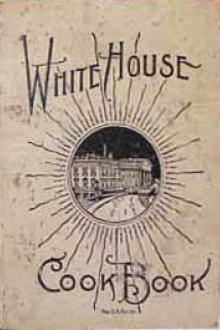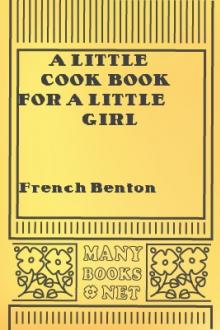The Whitehouse Cookbook (1887), Hugo Ziemann [world of reading .TXT] 📗

- Author: Hugo Ziemann
- Performer: -
Book online «The Whitehouse Cookbook (1887), Hugo Ziemann [world of reading .TXT] 📗». Author Hugo Ziemann
NUT CAKES. (Fried.)
Beat two eggs well, add to them one ounce of sifted sugar, two ounces of warmed butter, two tablespoonfuls of yeast, a teacupful of luke-warm milk and a little salt. Whip all well together, then stir in by degrees one pound of flour, and, if requisite, more milk, making thin dough. Beat it until it falls from the spoon, then set it to rise. When it has risen make butter or lard hot in a frying pan, cut from the light dough little pieces the size of a walnut, and, without molding or kneading, fry them pale brown. As they are done lay them on a napkin to absorb any of the fat.
TRIFLES.
Work one egg and a tablespoonful of sugar to as much flour as will make a stiff paste; roll it as thin as a dollar piece and cut it into small round or square cakes; drop two or three at a time into the boiling lard; when they rise to the surface and turn over they are done; take them out with a skimmer and lay them on an inverted sieve to drain. When served for dessert or supper put a spoonful of jelly on each.
PUFF-BALL DOUGHNUTS.
These doughnuts, eaten fresh and warm, are a delicious breakfast dish and are quickly made. Three eggs, one cupful of sugar, a pint of sweet milk, salt, nutmeg and flour enough to permit the spoon to stand upright in the mixture; add two heaping teaspoonfuls of baking powder to the flour; beat all until very light. Drop by the dessertspoonful into boiling lard. These will not absorb a bit of fat and are not at all rich and consequently are the least injurious of this kind of cakes.
GENERAL REMARKS.
Use the very best materials in making pastry; the shortening should be fresh, sweet and hard; the water cold (ice-water is best), the paste rolled on a cold board and all handled as little as possible. When the crust is made, it makes it much more flaky and puff much more to put it in a dish covered with a cloth and set in a very cold place for half an hour, or even an hour; in summer, it could be placed in the ice box.
A great improvement is made in pie crust by the addition of about a heaping teaspoonful of baking powder to a quart of flour, also brushing the paste as often as rolled out, and the pieces of butter placed thereon, with the white of an egg, assists it to rise in leaves or flakes. As this is the great beauty of puff paste, it is as well to try this method.
If currants are to be used in pies, they should be carefully picked over and washed in several waters, dried in a towel and dredged with flour before they are suitable for use.
Raisins, and all dried fruits for pies and cakes, should be seeded stoned and dredged with flour before using.
Almonds should be blanched by pouring boiling water upon them and then slipping the skin off with the fingers. In pounding them, always add a little rose or orange-water, with fine sugar, to prevent their becoming oily.
Great care is requisite in heating an oven for baking pastry. If you can hold your hand in the heated oven while you count twenty, the oven has just the proper temperature and it should be kept at this temperature as long as the pastry is in; this heat will bake to a light brown and will give the pastry a fresh and flaky appearance. If you suffer the heat to abate, the under crust will become heavy and clammy and the upper crust will fall in.
Another good way to ascertain when the oven is heated to the proper degree for puff paste: put a small piece of the paste in previous to baking the whole, and then the heat can thus be judged of.
Pie crust can be kept a week, and the last be better than the if put in a tightly covered dish and set in the ice chest in summer and in a cool place in winter, and thus you can make a fresh pie every day with little trouble.
In baking custard, pumpkin or squash pies, it is well, in order that the mixture may not be absorbed by the paste, to first partly bake the paste before adding it, and when stewed fruit is used the filling should be perfectly cool when put in, or it will make the bottom crust sodden.
HOW TO MAKE A PIE.
After making the crust, take a portion of it, roll it out and fit it to a buttered pie-plate by cutting it off evenly around the edge; gather up the scraps left from cutting and make into another sheet for the top crust; roll it a little thinner than the under crust; lap one-half over the other and cut three or four slits about a quarter of an inch from the folded edge (this prevents the steam from escaping through the rim of the pie, and causing the juices to run out from the edges). Now fill your pie-plate with your prepared filling, wet the top edge of the rim, lay the upper crust across the centre of the pie, turn back the half that is lapped over, seal the two edges together by slightly pressing down with your thumb, then notch evenly and regularly with a three-tined fork, dipping occasionally in flour to prevent sticking. Bake in a rather quick oven a light brown, and until the filling boils up through the slits in the upper crust.
To prevent the juice soaking through into the crust, making it soggy wet the under crust with the white of an egg, just before you put in the pie mixture. If the top of the pie is brushed over with the egg, it gives it a beautiful glaze.
FOR ICING PASTRY.
To ice pastry, which is the usual method adopted for fruit tarts and sweet dishes of pastry, put the white of an egg on a plate and with the blade of a knife beat it to a stiff froth. When the pastry is nearly baked, brush it over with this and sift over some pounded sugar; put it back into the oven to set the glaze and in a few minutes it will be done. Great care should be taken that the paste does not catch or burn in the oven, which is very liable to do after the icing is laid on.
Or make a meringue by adding a tablespoonful of white sugar to the beaten white of one egg. Spread over the top and slightly brown in the oven.
FINE PUFF PASTE.
Into one quart of sifted flour mix two teaspoonfuls of baking powder and a teaspoonful of salt; then sift again. Measure out one teacupful of butter and one of lard, hard and cold. Take the lard and rub into the flour until a very fine smooth paste. Then put in just enough ice-water, say half a cupful, containing a beaten white of egg, to mix a very stiff dough. Boll it out into a thin sheet, spread with one-fourth of the butter, sprinkle over with a little flour, then roll up closely in a long roll, like a scroll, double the ends towards the centre, flatten and re-roll, then spread again with another quarter of the butter. Repeat this operation until the butter is used up. Put it on an earthen dish, cover it with a cloth and set it in a cold place, in the ice box in summer; let it remain until cold; an hour or more before making out the crust. Tarts made with this paste cannot be cut with a knife when fresh; they go into flakes at the touch.
You may roll this pastry in any direction, from you, toward you, sideways, any way, it matters not, but you must have nice flour, ice-water and very little of it, and strength to roll it, if you would succeed.
This recipe I purchased from a colored cook on one of the Lake Michigan steamers many years ago, and it is, without exception, the finest puff paste I have ever seen.
PUFF PASTE FOR PIES.
One quart of pastry flour, one pint of butter, one tablespoonful of salt, one of sugar, one and a quarter cupfuls of ice-water. Wash the hands with soap and water and dip them first in very hot and then in cold water. Rinse a large bowl or pan with boiling water and then with cold. Half fill it with cold water. Wash the butter in this, working it with the hands until it is light and waxy. This frees it from the salt and buttermilk and lightens it, so that the pastry is more delicate. Shape the butter into two thin cakes and put in a pan of ice-water to harden. Mix the salt and sugar with the flour. With the hands, rub one-third of the butter into the flour. Add the water, stirring with a knife. Stir quickly and vigorously until the paste is a smooth ball. Sprinkle the board lightly with flour. Turn the paste on this and pound quickly and lightly with the rolling-pin. Do not break the paste. Roll from you and to one side; or if easier to roll from you all the time, turn the paste around. When it is about one-fourth of an inch thick, wipe the remaining butter, break it in bits and spread these on the paste. Sprinkle lightly with flour. Fold the paste, one-third from each side, so that the edges meet. Now fold from the ends, but do not have these meet. Double the paste, pound lightly and roll down to about one-third of an inch in thickness. Fold as before and roll down again. Repeat this three times if for pies and six times if for vol-au-vents, patties, tarts, etc. Place on the ice to harden, when it has been rolled the last time. It should be in the ice chest at least an hour before being used. In hot weather, if the paste sticks when being rolled down, put it on a tin sheet and place on ice. As soon as it is chilled, it will roll easily. The less flour you use in rolling out the paste, the tenderer it will be. No matter how carefully every part of the work may be done, the paste will not be good if much flour is used.
SOYER'S RECIPE FOR PUFF PASTE.
To every pound of flour allow the yolk of one egg, the juice of one lemon, half a saltspoonful of salt, cold water, one pound of fresh butter.
Put the flour onto the paste-board; make a hole in the centre, into which put the yolk of the egg, the lemon juice and salt; mix the whole with cold water (this should be iced in summer if convenient) into a soft, flexible paste with the right hand, and handle it as little as possible; then squeeze all the buttermilk from the butter, wring it in a cloth and roll out the paste; place the butter on this and fold the edges of the paste over, so as to hide it; roll it out again to the thickness of a quarter of an inch; fold over one-third, over which again pass the rolling-pin; then





Comments (0)